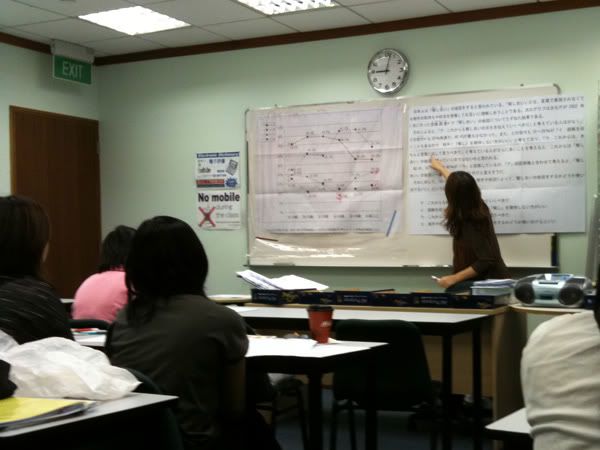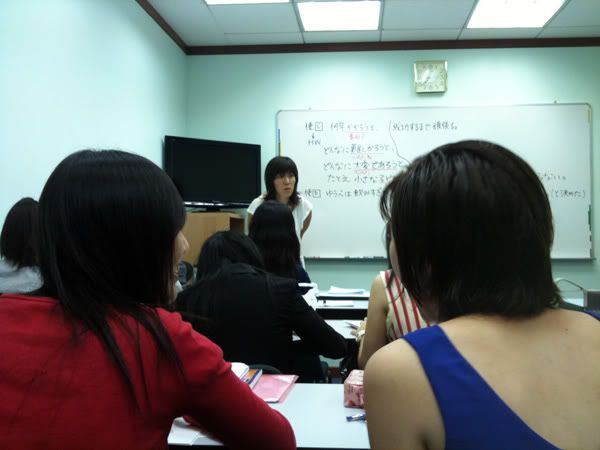I received my class 2B motorcycle license on the 3rd July 2015 (Friday). It has been a long journey.
Then again, the time I spent getting my class 2B is about the same duration as my class 3. It spanned a total of 7 months in all. The reason why I took such a long time is:
1) Overseas for 3 months - Basically I stopped my lessons from second half of December till end-February and was away momentarily in April again
2) Spreading out the learning experience - I do not like to undergo intensive learning activities (similar to mugging for exams), but prefer to gradually learn over a longer period of time. In this way, I can concurrently have my time allocated on other activities such as putting my work as priority, taking part-time courses and spending time with friends.
There were 9 of us, where we signed up as a group for the riding class with the Singapore Safety Driving Center (SSDC). Our first class was scheduled to commence on the 24 November 2014. I was very excited and looking forward to learning motorcycle. My only closest experience to motorcycle riding is cycling where it is one of my favorite pastime sports. As there was a minimum number of learners to be fulfilled before we can qualify for a private group, I rallied a number of my friends to go for it.
On our first lesson, we have our instructor explaining to us how to start up the bike, how to move the motorcycle from the main stand and put it back up the main stand.
After class, we immediately went to this motorcycle accessories shop recommended by an experienced learner. The shop is called Helmet Boy and is only a 10mins bus ride away from SSDC. It is located close to the Woodlands Causeway. There is this beginners package we can get which goes at a lower price. All we need to do is to produce our lessons booklet. I got mine for $85. It consist of a helmet, riding gloves and knee/elbow guards.
We have our lessons scheduled every Thursday and Friday afternoon, with 2 sessions each day spanning from 1.05pm till 5.20pm. We started our first lesson on the 27 Nov in controlling the clutch towards a set of yellow rubber tyres. As the instructors found us competent, they placed us in the nursery area which is a small round track where we sit on the bikes and move along in circles.
I had no prior experience with motorcycles but I have with bicycles. One of the habits from bicycle is to pull the right brake, which will brake the rear wheel. For motorcycle, the rear wheels brake is at the right paddle and the right brake controls the front wheel. It took me 4 lessons to overcome this habit.
At the same time, we also attended 2 full days of theory on the 2 Dec and 3 Dec where the instructors taught us about riding theory and defensive riding. From then onwards, my work commitment affected my ability to attend classes in December. I only attended 2 more classes in December - the 4th and 11th December. :-(
Even though I attended a few classes in November and December with my close friends, those were very memorable days. We took a 6-person group shot below while taking a break. Another 3 more friends were still riding on the circuit.
I resumed my classes on the 24 Feb after a 2.5 months break. By then many of my friends have gone onto road revision and were getting ready for exams. I did my theory exams in end-February and got 50/50. At the same time, I also resumed my once-twice a week lessons and having cleared lesson 5, I immediately booked my practical exams. I booked my exams to be on the 21 May as I was planning to take the test on the same day as a friend who was also weighted down by work.
As I'm still in private group sessions, I followed my friends and stopped my lessons in early-April. I have not figured out how to book public classes yet. Thereafter I resumed my overseas travel and only continued my lessons in early-May. By then, 3 of my friends have cleared their exams. I took another 2 more classes with another friend before I became a public class learner.
I took another 2 more classes before my test on the 21 May. My internal results is below. Overall, I'm very confident on the techniques to be used in the different courses.
When I closed my eyes, I'm able to clearly visualize the entire route and run it through from start to road and back to the circuit. It is similar to the Test Route paper as shown below (prepared by SSDC).
First test (21 May 2015 - Thursday)
My first test was on the 21 May 2015. The night before I could not sleep well as I went to bed too early, which was not my routine. The next day, I needed to wake up at 5.30pm and I had difficulty waking up. I took a cab to SSDC from my house and it cost around S$30. For the rest of the day, I felt sleepy and it's not my normal condition. I went through the circuit and all the routes were alright. But after the crank course, approaching the first traffic light while turning left, I may have accidentally hit on my rear break and my bike stopped immediately. My left leg came down to support the bike and it felt like a normal stop. I guessed one of the tester saw me doing that and gave me an immediate failure. I got 18 points for my entire test, of which 4 points x 2 (8 points) came from riding across traffic light while there's on-coming traffic in the distance, 6 seconds spent on pylon (4 points), and another 2 x 2 points from other minor stuffs. The tester called my number and explained to me my failure points and I went back home, feeling extremely sleepy.
I booked my next earliest test date on the 3 July (Friday). Traffic police offered me an earlier test date but I could not go for it. There were still lots of work I needed to do and going for motorcycle tests was taking a toll on my time. So I kept with the initial school booked date on the 3 July.
One week prior to the 3rd July test, I went for another 5 more sessions (2 hours each). Base on previous experience, I found that there was no point to go for too many sessions in one day. The critical test period is just the 20mins session. I also made some adjustments to my sleeping patterns. From Monday till Friday, I woke up at 5.30am, got to office early at 7am so as to minimize interruptions to my work, while I can still have motorcycle lessons in the evenings. This was to get my body clock ready for the early waking hours.
Second test (3 July 2015 - Friday)
Having maintained a momentum of waking up at 5.30am the last few days, I had no difficulty in falling asleep at night and waking up early in the morning.
As I did not have any preferred bikes amongst the bike pool, I just went down and picked a random bike. I am number 8 and got bike 78. I just noticed the bike staring straight at me. The warm-up was quite fun, especially at the figure-8 where the instructor told us to chase the bike in front to add a bit of tension.
The testers this time round were quite strict. Around 30% passed. We were told those who passed were either very good or very lucky. I believed it's more towards the former.
I departed from the starting point at 9.30am and got back around 10am. I went straight to canteen and began messaging my friends. I was very confident this time round as I did not make any silly mistakes. I knew my mind and body have been fully conditioned in all the techniques and circuits.
My name was not called and the remaining 15 riders celebrated. We have our instructor sharing with us the different bikes below.
I got 10 demerit points of which:
- 4 points - crossing traffic again without checking oncoming traffic (actually I did check but it's only after I have U-turned I realized the oncoming traffic is driving at an extremely fast speed - extremely fast subara sports car)
- 2 points - at the end of e-break, I looked downwards
- 2 x 2 points - minor stuffs
In the afternoon from 1pm, we went for the Expressway Familiarization Course. We started from SSDC and went into SLE and exited at Lentor Ave where we took a break at the entrance of Nanyang Poly. Below is our first group photo. We are the older generation group (all should be in the 40s-30s).
There were a few things I have learned from the Expressway Riding Course - pull down the visor before entering the expressway. The wind speed is so high that it will cause my eyes to tear. I have also decided to always wear my safety gear when I ride in the future. The observations I have made are: 1) Roads maybe slippery due to oil 2) Roads will become smooth due to wear and tear 3) Riding on fault lines and painted floors will reduce friction.
The video we watched after getting our results and saying the pledge helped as there is an obligation to our love ones. One of the riders who was in the same expressway orientation group as me is an airforce pilot, told me that the airforce do not encourage them to ride as they are supposed to take good care of their body. Likewise, I should also be taking good care of myself by following all the rules and be well-equipped with safety gears.
The instructors with SSDC are friendly and approachable. They are also
knowledgeable and I have great respect for them. It can really been seen
they are close with one another and truly work together as a team. Our
main instructors are Mohd Nizal, Shaikh, Sulaiman, Hasli, Chua CW and
Amir. There are also many others like Jaya, Suhaimi, Iskandar, Fuad and so on. I would like to salute them for their patience in guiding me. I will strongly recommend to anyone to sign up for Class 2B course with SSDC.
Will be looking forward to class 2A next year!!
Tips on passing class 2B test in SSDC
1) Condition your body to wake up early the week before the test as the sudden change in routine might affect your performance (from optimal to sub-optimal)
2) Practice the circuit and roads over and over again. I probably did the circuit more than a hundred times and the road more than 30 times.
3) Do all the safety check (blind spot, check-back, etc) in all practices. I did not have a single safety check penalty points as I did all of them listed in the map above.
4) Limit your practice to at most 2 hours each time with the first 30mins of practice being the most critical. It's the time when you sit on your bike to how fast you warm up that's important. The actual test is similar. The tester will wave for you to start after you have taken a 1.5 - 2.5 hours break in the waiting room. It's how fast your body psycho dynamics get started that is important.
5) Do not think too much. Everything about motorcycle is psycho dynamics which do not require much thinking. Do not imagine yourself falling off the plank or hitting the crank course kerb, it will make yourself more nervous. Just do it! (as Nike says). It's the zen-state of mind without thinking that's important.
6) Be courteous and always give way. When in doubt at traffic light junctions, stop. It happened to me several times during test. A big bendy bus turning in front of me, fast sports car oncoming, big vehicles undergoing tests with unpredictable speed, pedestrian or cyclist coming your way while the light is red, etc. Slow down to gear 2 in traffic junction to react in time. If in doubt, just stop.
7) If you have difficulty sleeping, turn on the light and read some boring book. It will definitely make you fall asleep. Repeat it a few times if you woke up after sleeping.
8) Circuit tips
- Slope: Check-back. Keep your right sole on the back brake pedal and start to accelerate. When you start to feel the bike will not roll backwards, accelerate more and slowly release clutch. At the same time release the brake pedal and accelerate more. All these should be done in less than 5 seconds.
- Figure 8: Prior to entering figure 8, incline more towards the right after starting point. This will give you a smoother angle when you make a left turn into figure 8. Accelerate more into gear 2 and go around it. The important technique is to look at a distance. You will need to look half a circle away each time. Do not look down or too near as your speed will be reduced.
- Crank Course: Go in fast at gear 1. Immediately after the entrance, change to gear 2 and move in. This should be fast and completed in less than 5 seconds.
- Emergency Break: Go in fast, with your eyes occasionally checking the >30km/hr lights in front of your bikes to be on. Upon reaching the cone area, just look straight and don't look down and brake.
- Plank: The key factor here is clutch control. After move-off at gear 1, and after your front wheel has got onto the plank, pull in your clutch immediately. Do not do anything except holding on to your clutch. You can use brake if you are confident you will not fall off or brake too much. Once you have pulled in your clutch, its very easy to remain stable on the plank. It's just adjusting the handle bar from there on.
- Pylon Salom: Change to gear 2 at the midway point between starting and the first cone. Enter in the middle and use your body and handle bar to move around. Look at a distance.



















